Indianapolis is a center of justice as the site of federal, state, and county courts. During Marion County’s founding decade all three judicial branches—the U.S. District Court, the Indiana Supreme Court, and the local trial court—shared the county’s first courthouse. The city’s only public building from 1825 to 1835 was also the meeting place for the Indiana General Assembly.
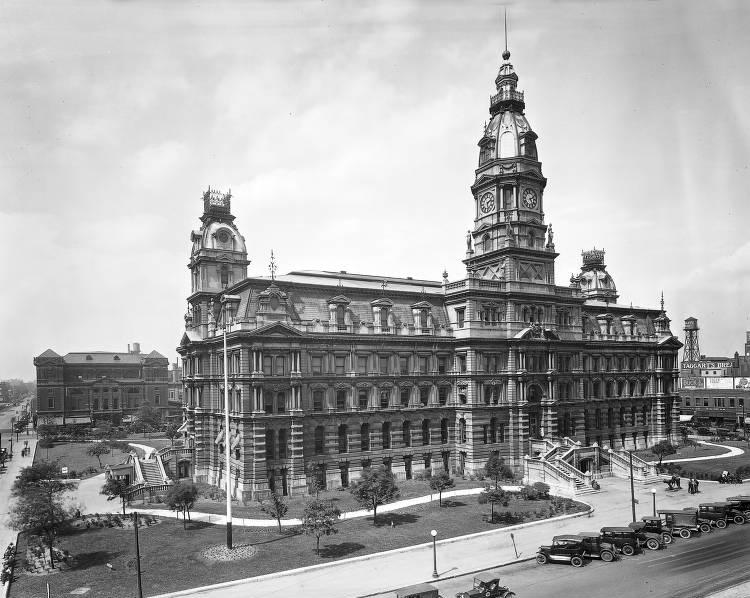
By 2020, courts of all levels were ubiquitous features of Indianapolis, routinely deciding the matters of life, liberty, money, and property. More than 5,000 lawyers currently practice in the courts of Marion County, which is quite a leap from the 10 lawyers who were admitted to practice in the county when its circuit court held its first session on September 26, 1822, in a double log cabin home.
As the state capital, Indianapolis has figured in a distinctive way in the evolution of law. Because the General Assembly meets here, tests of its enactments, such as the sales tax of 1961, have originated in the local Circuit Court and been resolved on appeal by the state Supreme Court. When federal issues have been involved, such as with redistricting of the General Assembly, they have been decided by the local U.S. District Court.
The roots of the judicial systems are in the United States and Indiana constitutions, which set out the basic jurisdiction of their respective courts. While the state constitution established the Indiana Supreme Court and the local Circuit Court, the local Superior Court, Municipal Court, and Small Claims Courts were created by acts of the General Assembly.
United States District Court for the Southern District of Indiana
Pursuant to Article III of the United States Constitution, the federal judicial power is vested in the federal court system, which in modern times is comprised of 94 locally based federal districts, 12 regionally based courts of appeals (along with the Federal Circuit Court of Appeals), and the Supreme Court. “Article III judges,” as they are referred to, are appointed by the president of the United States with the advice and consent of the United States Senate to life-tenured positions that the judges retain “during Good Behavior,” which means they can be removed from office only by impeachment.
The United States District Court for the Southern District of Indiana is one of the 94 federal judicial districts, and its flagship courthouse, located in Indianapolis, occupies the city block bordered by Meridian, New York, Pennsylvania, and Ohio streets one block north of Monument Circle. It has occupied this location since 1903 (see ).
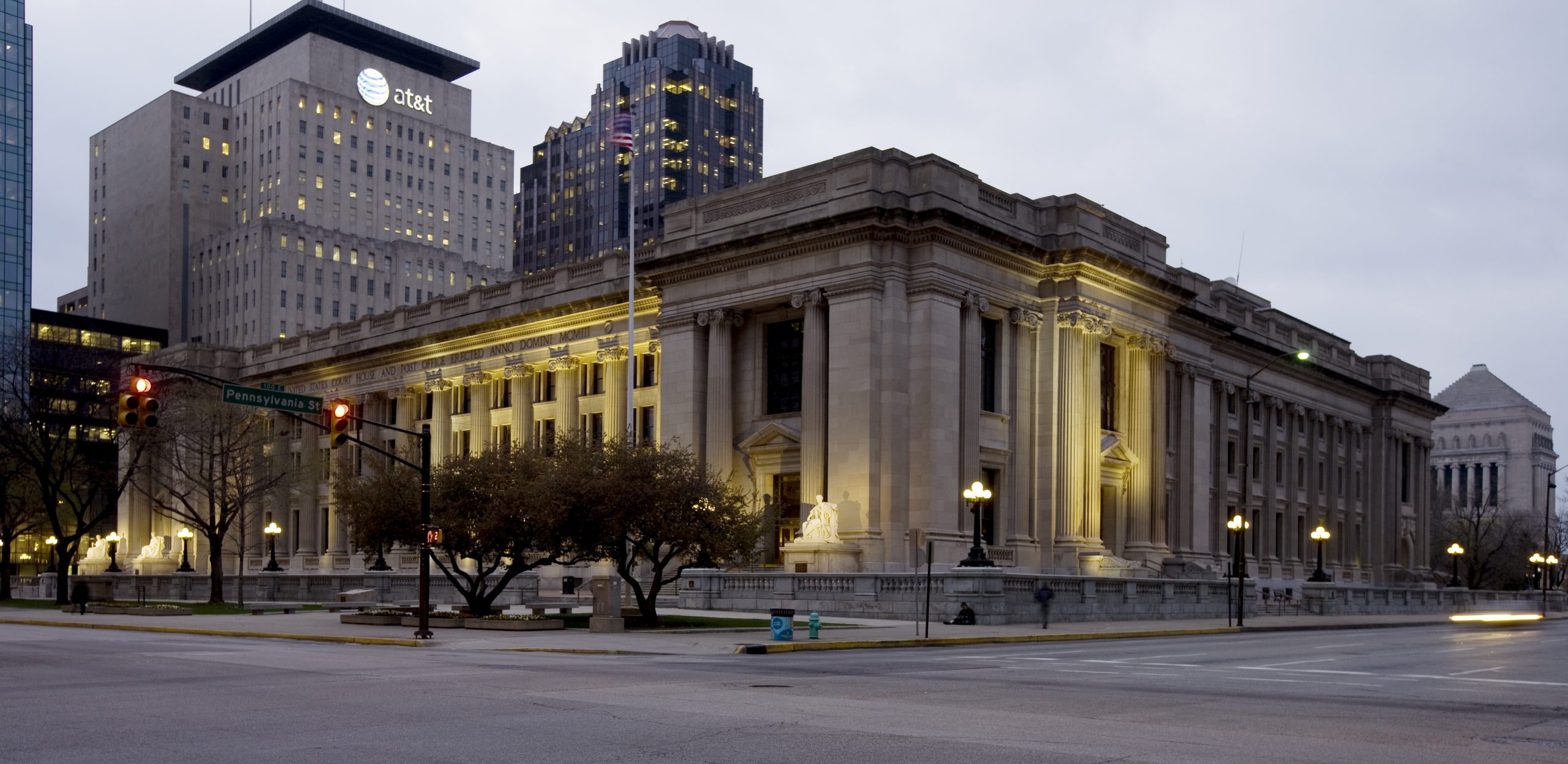
Renamed the Birch Bayh Federal Building and United States Courthouse after being officially dedicated on October 24, 2003, in honor of former United States Senator Birch Bayh (1928-2019), it provides space for the courtrooms and judicial chambers for the District Court judges, magistrate judges, and bankruptcy judges as well as their respective clerks of court and administrative offices, a law library, the probation department, the U..S. Tax Court and U.S. Marshal’s office and a variety of smaller agency offices.
Until 1860, there was no federal building in Indiana’s capital city. National governmental offices were scattered at various locations throughout the state. The federal District of Indiana was first established in 1817, but the federal judges borrowed courtroom space from Indiana’s Supreme Court in the State House for trials and hearings. Their individual judicial chambers were maintained in the judges’ private homes.
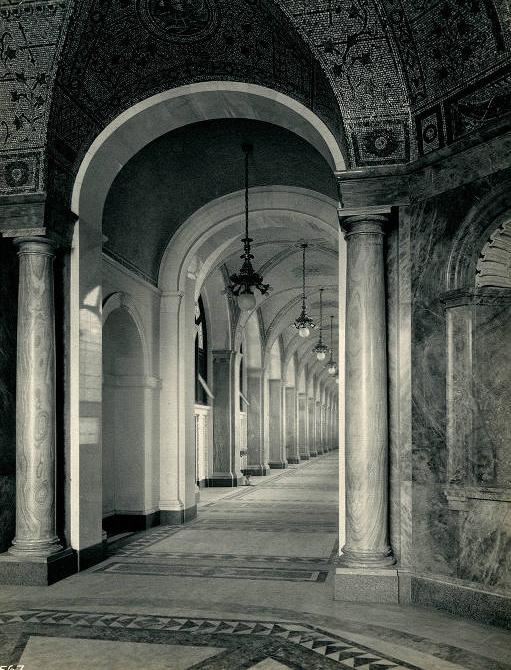
In 1856, a congressional appropriation authorized the construction of the first federal building, and in 1860 the Government Building was erected in the form of a four-story stone structure at the southeast corner of Pennsylvania and Market Streets. It opened for business in downtown Indianapolis and allowed all the federal agencies in Indiana to operate under one roof for the first time.
Over the ensuing four decades, the federal workload grew and the number of federal offices expanded. In 1902, the entire city block at the northeast corner of Meridian and Ohio Streets, where the court currently is still located, was purchased and ground broken for the new United States Court House and Post Office. The cornerstone was laid on March 25, 1903, and the building opened for business in September 1905. The final cost of construction was nearly $2 million.
This dramatically beautiful Beaux-Arts style structure, when completed, accommodated 925 federal employees and housed the main Post Office, executive offices, and the federal courts. The Post Office’s sorting and customer service facilities were located on the first floor and the second floor housed two monumental courtrooms, the judges’ chambers, the office of the Clerk of the Court, the United States Marshal’s office, the United States Attorney’s office, and the Judges’ Library.
The architecture was suggestive of Rome, where civil law originated, and many Roman symbols of government, justice, courts, transportation, communication, and commerce are incorporated in the mosaics, stained glass, casing, and decorative murals and plasterwork in the building.
Between 1936 and 1938, the Court House and Post Office building was expanded by adding a northern addition, which filled out the city block. Following the Great Depression, new federal programs again increased the number of federal agencies and employees occupying the building and increased the amount of federal litigation. This required more space for the District Court, the United States Attorney, United States Marshal, Probation Offices, and other agencies. By the early 1970s, construction of the Minton-Capehart Federal Building at Pennsylvania and Michigan Street, and a new main Post Office at South and Capitol streets relieved the crowded conditions in the original Court House and Post Office.
For more than two centuries, the judges serving the courts of the United States in Indiana have been called upon to resolve highly significant legal, political and social problems of the day. When the judicial District of Indiana was created on March 3, 1817, Benjamin Parke was appointed as the first district judge three days later. The Court first met in Corydon, Indiana, on May 5, 1817, and was moved eight years later to Indianapolis in January 1825, along with the move of the state government.
One district judge served the entire state of Indiana until 1928, at which time Congress split the District of Indiana into the Southern District and Northern District. The Southern District of Indiana consists of the southern 60 counties, ranging geographically from Howard County on the northern border down to the Ohio River. A single judge continued to serve the judicial needs of the entire Southern District until 1954. In addition to Indianapolis, the Court holds regular sessions at three divisional courthouses located in New Albany, Evansville, and Terre Haute.
In 1954, Indiana was included in a nationwide expansion of the federal district courts. Thereafter, in 1961, 1966, and 1978, the southern district was authorized an additional judge, becoming a five-judge court. The expansion was justified by the increases in caseloads and the need to better serve this increasingly diverse population, given the demands of a growing economy with many large, flourishing industrial enterprises, the growth of organized labor, the increased prominence of healthcare and professional sports, the burgeoning influence of state government, the increased role of national and international transportation, and the size and prestige of universities and colleges.
The U.S. District Court for the Southern District of Indiana is comprised of five full-time district judges. The Judicial Conference of the United States has authorized four bankruptcy judges and five magistrate judges to serve the court and the residents of the southern district. The Magistrate Judgeships and Bankruptcy Judgeships are the creatures of statutes (rather than the Constitution) and were formed and installed to assist in managing the increasing demands of the court dockets.
Members of the District Court bench have included former Indiana Supreme Court justices, former members of Indiana’s General Assembly, a former member of the U.S. House of Representatives, and numerous distinguished leaders of the bar. The first woman federal judge in Indiana, Sarah Evans Barker, was appointed to the Southern District court in March 1984, and the first African American federal judge in Indiana, Tanya Walton Pratt, joined the court in June 2010.
As a group, the district court judges have presided over a wide array of complex, often groundbreaking cases presenting challenging issues of criminal law, patents and trademarks, prison conditions, voting rights, anti-trust and securities law disputes, libel, government corruption, busing, federal and state regulatory actions, obscenity, school prayer, employment disputes, mass torts, environmental clean-up, abortion, educational and welfare policies, ownership of international art antiquities, public health and religious liberty.
Indiana Appellate Courts
Even though the Indiana Supreme Court has met in the same location longer than any other court of last resort in America, it has actually had several homes over the past two centuries. During the initial years of Indiana statehood, the Supreme Court convened at the Corydon capitol. Then in 1824, the General Assembly approved legislation establishing Indianapolis as the permanent seat of state government and setting aside space for the Supreme Court in the Marion County courthouse. The Supreme Court’s first term in the new state capital was gaveled into session on May 2, 1825.
The 1816 Indiana Constitution provided for a three-judge Supreme Court appointed by the governor. The first Supreme Court judges to sit in Indianapolis—James Scott, , and —all hailed from other states and had practiced law in southern Indiana prior to their appointment to the bench.
Blackford had become a bit of a recluse following the death of his wife in childbirth in 1821 and upon moving to Indianapolis took up residence in a sparsely furnished room in the vacant Governor’s house on the Circle. He and the other judges also had their chambers in the Governor’s house and regularly met there for consultation before sessions at the courthouse.
In 1835, the Supreme Court moved to the newly constructed on the northwest corner of Washington Street and Capitol Avenue but the judges continued to utilize the house on the Circle for their offices and law library until the crumbling and derelict building was demolished in 1857.
The first Indianapolis State House soon proved inadequate for the growing needs of state government, which included an expanded Supreme Court. The new state constitution adopted in 1851 had authorized the statewide election of three to five Supreme Court judges, each representing a separate district, and in 1852, the General Assembly split the state into four judicial districts. Twenty years later, the legislature added a fifth judge and fifth district to address a backlog of cases.
In 1867, the General Assembly enacted a statute providing for a new building for the Supreme Court and other state officers. Constructed directly across from the State House on Washington Street, the new brick building housed the Supreme Court judges and the Supreme Court library for the next 30 years, until the court moved to the new State House in 1889.
Once again, however, it seems that state planners had underestimated the amount of space needed to operate the three branches of state government. Just three years after the new State House was completed in 1888, the number of appellate judges would double when the legislature established the five-judge Indiana Appellate Court to help address the out-of-control backlog of cases pending before the Supreme Court. Nearly half of the rooms in the Statehouse reserved for House and Senate committee meetings were now needed for the new judges and their courtroom.
By 1911, and state lawmakers began exploring solutions to alleviate the cramped and overcrowded conditions in the capitol building. One proposed solution that was widely discussed but failed to gain traction was the erection of a new building to house the judicial branch. This would free up space for the burgeoning number of executive branch agencies.
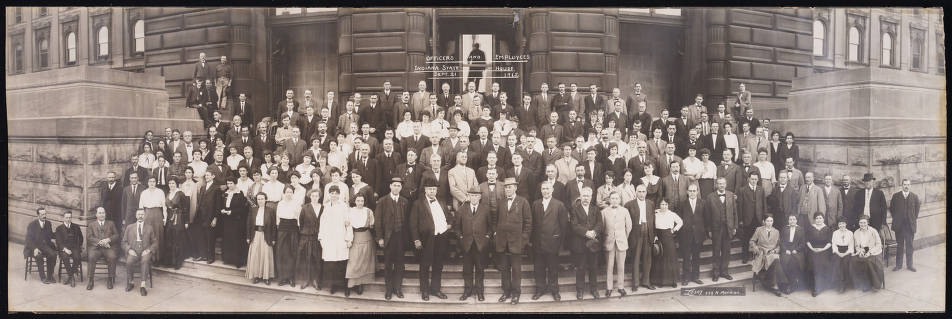
By the late 1960s, the General Assembly was clamoring for more space. Legislation in 1971 appropriated $50,000 to the State Office Building Commission to plan a new judicial building. The project was shelved by then-Gov. Ed Whitcomb, and in 1974, the Commission was tasked with a review of all of the state’s space needs, with the new judicial center no longer set as the top priority.
After more than a decade of studies and planning, in 1987 the Commission adopted a master plan that included construction of both a new state office building and a new judicial building. The proposed site for the judicial building was a parking lot directly north of the Statehouse. By the next year, however, the projected costs for the judicial building had ballooned from $50 million to $90 million and became an issue in the gubernatorial campaign, with both candidates calling for the drastic changes in the proposed building’s ornate design. The plans for the stately limestone and granite judicial building were permanently scuttled after then-Secretary of State Evan Bayh defeated Lt. Gov. John Mutz in the November 1988 election.
In 1999, the concept of a separate building for the judicial branch was briefly revived when lawmakers appropriated $4 million for a feasibility study. The following year, the General Assembly authorized the State Office Building Commission to issue bonds to finance construction of the judicial building. The bill was vetoed by Gov. Frank O’Bannon.
Most of the Supreme Court’s various agencies are housed in leased space in downtown Indianapolis. The Justices and their staffs, and a few court employees, continue to maintain offices in the State House, and the Court continues to hear and decide cases in its historic State House courtroom and conference room as it has for more than 130 years.
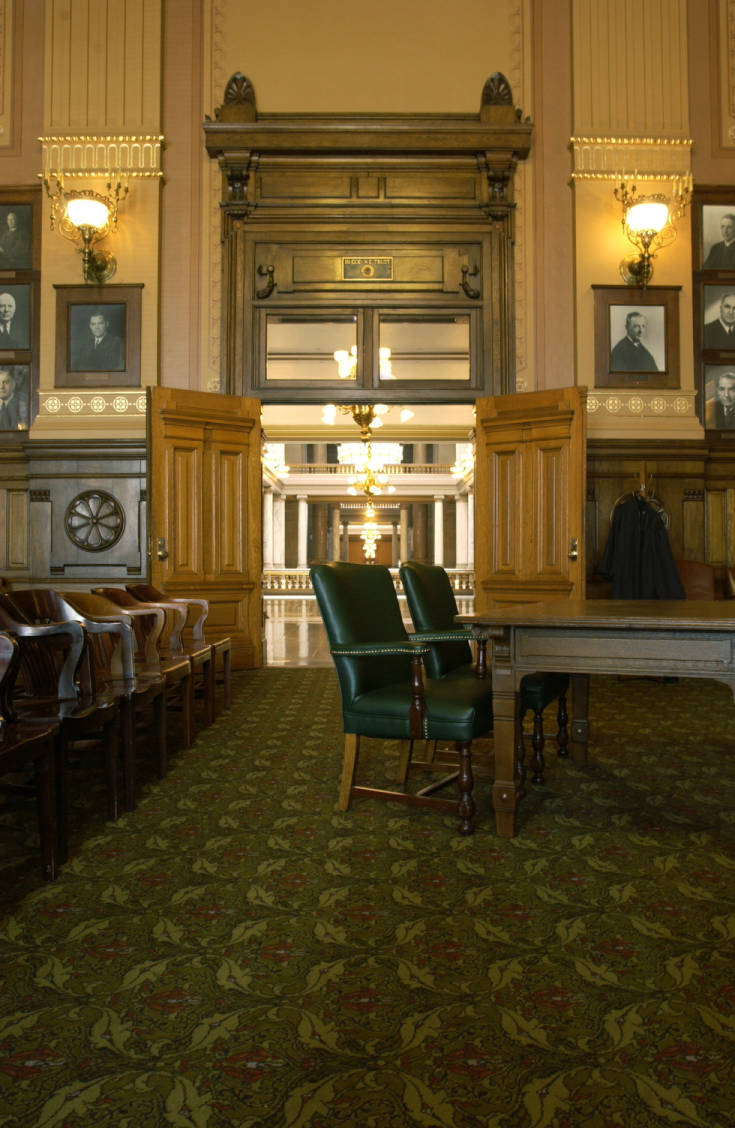
The presence of the state’s highest court in Indianapolis for nearly 200 years has left a lasting impact on the city. Although the first Indianapolis native ever elected to the Court, Charles A. Ray, moved to Washington, D.C., when he lost his bid for reelection in 1870, many former Supreme Court judges who originally hailed from other parts of the state have remained in Indianapolis after they returned to private practice, teach at the law school, or contribute to the community in myriad other ways.
The five Supreme Court districts drawn in 1872 remained in place for the next century, which guaranteed that there would never be more than one judge on the Court from Indianapolis. In 1970 a constitutional amendment removed Supreme Court judges from political election, made them appointive by the governor for 10-year terms, and had them stand unopposed on general election “yes or no” retention ballots.
At the same time, the official title “Justice” was adopted for judges serving on the state Supreme Court. The 1970 amendment also enshrined the appellate court into the state Constitution and changed its name to the Indiana Court of Appeals. Its 15 judges sit in 3-judge panels and handle all civil appeals and appeals of criminal sentences of 50 years or less. A third appellate court, the Indiana Tax Court, was established in 1986 to handle appeals of administrative rulings involving sales, income, and property taxes.
In November 2000, voters approved a change in the Indiana Constitution that removed the requirement that every criminal case with a sentence in excess of 50 years be appealed directly from the trial court to the Supreme Court. These mandatory criminal appeals had been consuming a greater and greater share of the Supreme Court’s docket, which limited its ability to focus on other areas of the law.
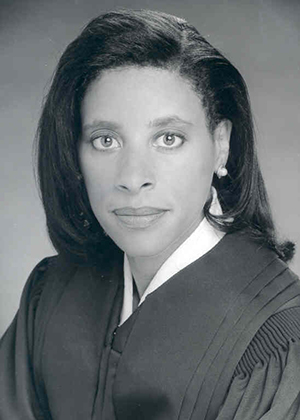
In 1995, Indianapolis attorney Myra Selby became both the first woman and the first Black Hoosier appointed to the Indiana Supreme Court. Selby retired from the Court in 1999, and 13 years would pass before another woman would be named to the state’s highest court. Appointed to the Supreme Court in 2012, Loretta H. Rush has served as chief justice since 2014.
The longest-serving judge on the Indiana Supreme Court was also one of the first judges to serve on the Court when it relocated to Indianapolis from Corydon in 1825. Judge Isaac Blackford, the brilliant recluse who lived in an upstairs room in the unused Governor’s house on the Circle, was on the Supreme Court bench from 1817 to 1853—a record 12,899 days. Blackford Street on the IUPUI campus bears his name.
Local Trial Courts
As the state’s most populous county, Marion County has been in the vanguard of change at the trial court level. The legislature gave the county the state’s first Criminal Court in 1865; its first Superior Court in 1871; the first Juvenile Court in 1903 (indeed, one of the nation’s first ); and the first Municipal Court with appointed judges in 1925. In addition, Marion County has been an incubator of innovation with such agencies as the Domestic Relations Counseling Bureau and special mental health and environmental divisions of its Municipal Court.
The first circuit judge to sit in Marion County, William W. Wick, was called the “president judge” and served with two associate judges. A Connersville native, Wick was elected by the legislature and moved to Indianapolis in the spring of 1822. The court’s circuit covered a large area comprised of 16 counties that are present in 2020, and did not become a one-county circuit until 1889.
The first session of the Circuit Court in Marion County convened on September 26, 1822. The judges took their oaths of office, which at the time included an oath against dueling. Ten attorneys were admitted to practice, only three of whom were residents of the pioneer settlement. By law, the court was required to meet at the cabin of the state agent, Gen. John Carr, until such time as the courthouse was completed. That location proved to be too small, however, so the court adjourned to Jacob Crumbaugh’s house at the southwest corner of Market and Missouri Street. Crumbaugh, who served as justice of the peace, was paid $7.50 for the use of his house. Subsequent sessions of the court were held at Henderson’s Tavern or private homes until the new courthouse was ready for occupancy in 1824.
Alcohol issues dominated the initial session in 1822. The court issued a tavern license to John Hawkins for his hotel on the northside of Washington Street between Meridian and Pennsylvania streets. Prominent early Indianapolis resident was appointed prosecuting attorney, and a grand jury was impaneled that returned 22 indictments for selling liquor without a license and other misdemeanors.
While Judge Wick heard a full range of civil and criminal cases, state lawmakers soon began creating specialized courts. Some of these courts were part of a statewide system; others were unique to the state capital.
In 1829, the General Assembly established a statewide system of probate courts. Probate judges were paid a pittance and typically had no legal training. Twenty years later, the legislature established a Common Pleas Court for the county. The Common Pleas Court along with the probate court was abolished in 1852 when the General Assembly enacted legislation creating a state system of Common Pleas courts, specifically charged with probate responsibilities but also given concurrent jurisdiction with the Circuit Court on a range of civil and criminal matters.
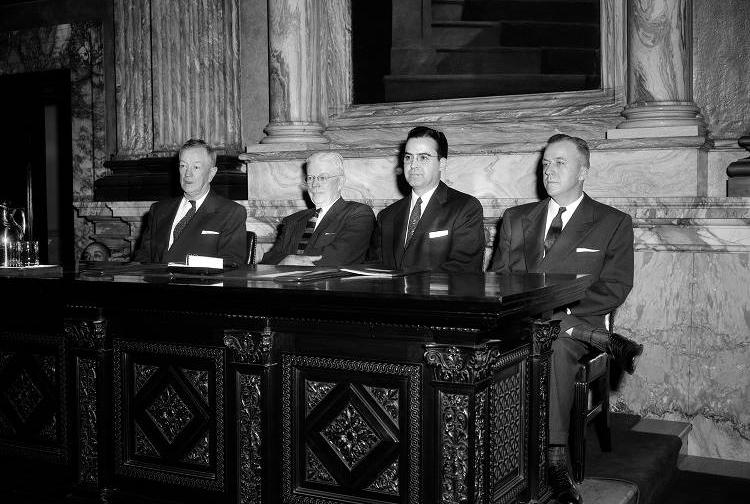
The common pleas courts were abolished in 1873 and all of their pending cases were transferred to the circuit courts. In 1865, the first criminal courts were established in Marion County to provide relief to the circuit court from its crushing caseload. The three-judge Superior Court of Marion County was created in 1871.
Marion County formerly had separate Criminal, Superior, Juvenile, and Probate courts, but a 1975 statute joined them under one Superior Court. The reorganization provided for a presiding judge, elected by the other judges, who was responsible for the operation and conduct of the court under rules adopted by the court. The reorganization further provided for civil, criminal, probate, and juvenile divisions, although judges were elected without any specific division being named on the ballot.
Prior to 1975, each party nominated candidates for all judgeships on the Superior Court but, after complaints that irrelevant national issues, such as Watergate and the Vietnam War, could sweep an entire sitting bench out of office, a 1975 law adopted a bipartisan plan for the election of the Superior Court’s then 13 members. The plan called for the Republican and Democratic parties each to nominate seven candidates to be voted on in the general election. The 13 receiving the highest number of votes were declared elected, meaning 7 of the majority party and 6 of the minority party. The Circuit Court, created by the constitution and not by statute, was outside of the reorganization and both parties continued to nominate candidates for that position.
The Municipal Court originated in 1925 as a bipartisan court, with judges from both political parties appointed by the governor. The judges operated independently of each other until a 1969 act placed a presiding judge over the 10 trial judges to seek the “speedy economical and uniform disposition of cases.”
That reorganization was followed in 1971 by a law creating a Judicial Nominating Commission for the Municipal Court. Established in response to charges that some judges should be removed because of cronyism with lawyers, the panel screened candidates and nominated the “most highly qualified” for appointment by the governor.
The 1990s brought sweeping changes for the municipal court. The legislature removed the distinction between superior and municipal court judges. All Marion County trial judges, with the exception of the constitutionally elected circuit court judge, were considered superior court judges with general and concurrent jurisdiction. Together with the former municipal court judges and new judgeships authorized by the legislature over the years, the Superior Court now consisted of 35 judges. The Court also consolidated its court services with the hiring of a court administrator and supporting staff to prepare unified court budgets and streamline administrative processes.
Under the leadership model, three judges were elected to serve on the Executive Committee of the Marion Superior Court. The three judges could not be of the same political party. The Executive Committee was led by a presiding judge with the other two members known as associate presiding judges. This model continued until the mid-2000s when the statute was amended to add an additional court which brought the total number of Superior Court judges to 36. The judges were evenly divided by political party with 18 Republican judgeships and 18 Democrat judgeships. In addition, the Executive Committee became a four-member committee with the control switching between the two political parties every two years.
A federal judge ruled that system unconstitutional in 2015, and the state legislature passed a sweeping judicial selection reform system in 2017. The new system changed the way in which Marion Superior Court judges moving forward would be selected. Future vacancies would no longer be filled via an election in the two-party system but instead, applicants would be vetted by a 14-member judicial selection committee who put forth three candidates to the governor for appointment. Incumbent judges must go before the same committee at the conclusion of their respective six-year terms for a recommendation as to whether or not they are qualified to continue service on the bench. Incumbents must then stand before the electorate in a retention vote.
Following a successful pilot project, the Indiana Supreme Court in 2019 issued an order permanently establishing commercial courts in Marion County and five other Indiana counties. These specialized courts are geared toward allowing business and commercial disputes to be resolved with expertise, technology, and efficiency, which in turn will enhance the accuracy, consistency, and predictability of decisions in business and commercial cases. Marion Superior Court Judge Heather Welch was appointed as the first judge of the county’s commercial court.
Big changes occurred on the diversity of the bench in the last decade as well. In 2014, Marion County voters elected the first African American female to the Marion Circuit Court in Judge Sheryl Lynch. In 2019, Marion Superior Court judges elected its first all-female executive committee.
The trial courts are expected to move to a new Community Justice Campus in the spring of 2022. This will be the first time all Marion County trial courts will be housed under the same roof and also the first time the courts will be outside of the downtown mile square.
Small Claims Court
Since pioneer times held court to handle small claims and minor offenses. The JPs often were persons untrained in the law, and their compensation was dependent on fees and fines they might assess. Those courts were abolished in 1975 and a Small Claims Court for Marion County was created effective January 1, 1976.
A separate small claims court exists in each of the county’s nine townships with jurisdiction over claims that do not exceed $8,000 (Effective July 1, 2015. See Ind. Code 33-34-3-2). The judges of these courts are elected by the voters of their respective townships. Although procedures in the small claims court are less formal than in courts of general jurisdiction, i.e., circuit and superior courts, criticism of their operations resulted in several reforms during the 2015-2018 time frame, including a requirement that each court is a full-time court. This is appropriate because these courts handle a very substantial volume of cases.

Help improve this entry
Contribute information, offer corrections, suggest images.
You can also recommend new entries related to this topic.